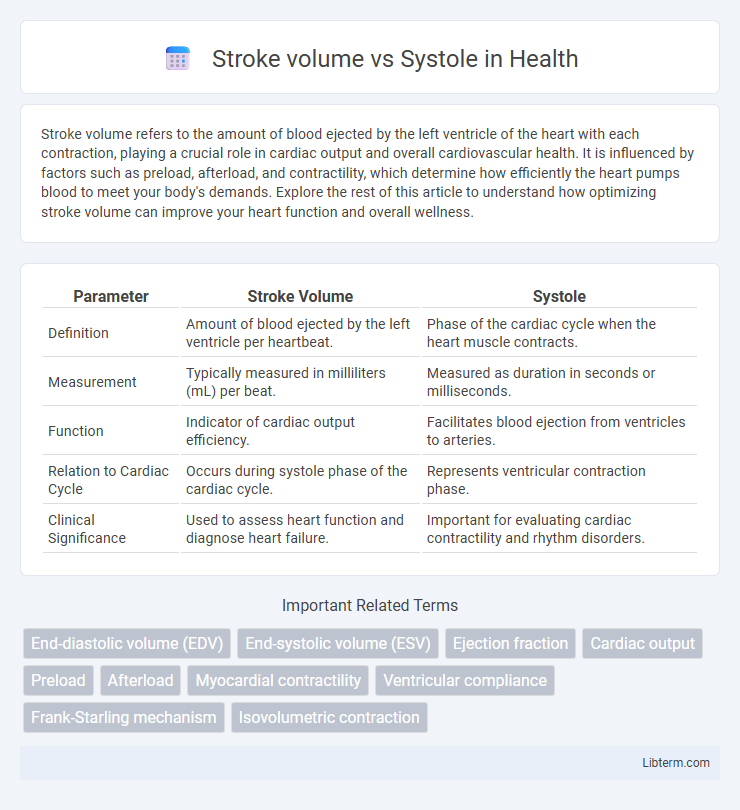Stroke volume refers to the amount of blood ejected by the left ventricle of the heart with each contraction, playing a crucial role in cardiac output and overall cardiovascular health. It is influenced by factors such as preload, afterload, and contractility, which determine how efficiently the heart pumps blood to meet your body's demands. Explore the rest of this article to understand how optimizing stroke volume can improve your heart function and overall wellness.
Table of Comparison
| Parameter | Stroke Volume | Systole |
|---|---|---|
| Definition | Amount of blood ejected by the left ventricle per heartbeat. | Phase of the cardiac cycle when the heart muscle contracts. |
| Measurement | Typically measured in milliliters (mL) per beat. | Measured as duration in seconds or milliseconds. |
| Function | Indicator of cardiac output efficiency. | Facilitates blood ejection from ventricles to arteries. |
| Relation to Cardiac Cycle | Occurs during systole phase of the cardiac cycle. | Represents ventricular contraction phase. |
| Clinical Significance | Used to assess heart function and diagnose heart failure. | Important for evaluating cardiac contractility and rhythm disorders. |
Understanding Stroke Volume: Definition and Importance
Stroke volume refers to the amount of blood ejected by the left ventricle of the heart during each systolic contraction, typically measured in milliliters per beat. It plays a crucial role in determining cardiac output, which is calculated as stroke volume multiplied by heart rate, reflecting the efficiency of the heart's pumping ability. Understanding stroke volume is essential for evaluating cardiovascular health, as abnormalities can indicate conditions such as heart failure or valve dysfunction.
What Is Systole? Phases and Functions
Systole is the phase of the cardiac cycle during which the heart's ventricles contract, propelling blood into the aorta and pulmonary artery. It consists of two main phases: isovolumetric contraction, where ventricular pressure rises without volume change, and ventricular ejection, during which blood is expelled from the ventricles. Systole functions to generate stroke volume, the amount of blood pumped per heartbeat, critical for maintaining effective circulation and tissue perfusion.
Stroke Volume vs Systole: Key Differences
Stroke volume refers to the amount of blood ejected by the left ventricle during each heartbeat, typically measured in milliliters per beat, while systole is the phase of the cardiac cycle during which the heart muscle contracts to pump blood out of the chambers. The key difference lies in stroke volume being a quantifiable output reflecting cardiac efficiency, whereas systole denotes the mechanical action of contraction itself. Understanding these distinctions is essential for evaluating cardiac function and diagnosing cardiovascular conditions.
The Physiology Behind Stroke Volume
Stroke volume represents the amount of blood ejected by the left ventricle during systole, which is the contraction phase of the cardiac cycle. The physiology behind stroke volume involves preload, afterload, and myocardial contractility, where preload refers to ventricular filling, afterload to resistance against ventricular ejection, and contractility to the strength of myocardial contraction. Changes in these factors influence stroke volume by affecting the volume of blood pumped with each heartbeat during systole.
Systole: Its Role in the Cardiac Cycle
Systole plays a crucial role in the cardiac cycle by initiating ventricular contraction, which propels blood into the arteries and determines stroke volume. The efficiency of systole directly influences stroke volume, as stronger ventricular contractions result in a higher volume of ejected blood per heartbeat. Understanding systole's mechanics is essential for assessing cardiac output and overall heart function.
Factors Influencing Stroke Volume
Stroke volume is the amount of blood ejected by the left ventricle during systole, directly influenced by preload, afterload, and myocardial contractility. Preload, determined by venous return and end-diastolic volume, affects ventricular stretch and stroke volume according to the Frank-Starling law. Increased afterload, often due to hypertension or aortic stenosis, reduces stroke volume by raising resistance against ventricular ejection.
Clinical Significance of Systole in Heart Health
Systole, the phase of the cardiac cycle when the heart contracts and pumps blood, directly influences stroke volume, the amount of blood ejected with each heartbeat. Clinically, the efficiency and duration of systole are critical indicators of heart health, as abnormalities can signal conditions such as heart failure or systolic dysfunction. Monitoring systolic function through echocardiography and measuring stroke volume helps in diagnosing cardiovascular diseases and guiding treatment strategies.
Stroke Volume and Systole in Heart Disease
Stroke volume, the amount of blood ejected by the left ventricle during systole, is a critical indicator of cardiac function in heart disease. During systole, the heart contracts to pump blood, and impairments in this phase can reduce stroke volume, leading to symptoms such as fatigue and shortness of breath. Monitoring stroke volume in patients with heart disease helps assess the severity of myocardial dysfunction and guides therapeutic interventions to improve cardiac output.
Measuring Stroke Volume and Systolic Function
Stroke volume, the amount of blood ejected by the left ventricle during systole, is a key indicator of cardiac performance measured using echocardiography or cardiac MRI through parameters like end-diastolic and end-systolic volumes. Systolic function assessment involves analyzing ejection fraction and myocardial strain to determine ventricular contractility and overall heart efficiency. Accurate measurement of stroke volume and systolic function aids in diagnosing heart failure and monitoring treatment efficacy.
Improving Cardiac Performance: Focus on Stroke Volume and Systole
Stroke volume and systole are critical parameters for improving cardiac performance, with stroke volume representing the amount of blood ejected by the left ventricle during each contraction and systole referring to the phase of the cardiac cycle when the heart contracts. Enhancing stroke volume through increased preload, myocardial contractility, or reduced afterload directly improves cardiac output and efficiency during systole. Optimizing these factors supports better oxygen delivery and overall cardiovascular health, making stroke volume and systolic function key targets in cardiac performance improvement strategies.
Stroke volume Infographic

 libterm.com
libterm.com